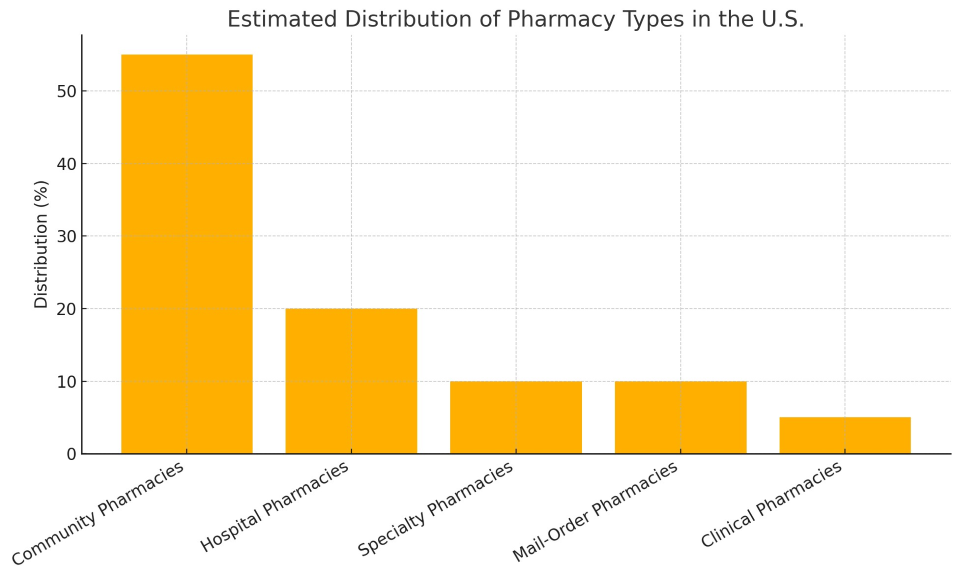Pharmacy services are a fundamental component of healthcare in the United States. From dispensing medications to delivering preventive care, pharmacists are often the most accessible healthcare professionals in the system. As patient needs and healthcare technologies evolve, so does the role of the pharmacy. This article explores the types, functions, and future of pharmacy services across the U.S. healthcare landscape—complete with data, charts, and real-world examples.
The Expanding Role of Pharmacies in U.S. Healthcare
Pharmacies have grown from simple medication dispensaries into full-service health hubs. Today, pharmacists:
-
Provide medication therapy management (MTM)
-
Administer vaccines
-
Monitor chronic diseases
-
Offer lifestyle counseling
-
Conduct health screenings
According to the CDC, over 90% of Americans live within five miles of a community pharmacy. This level of access makes pharmacies critical to public health infrastructure—especially in rural and underserved areas.
Types of Pharmacies and Their Distribution
The U.S. pharmacy ecosystem is diverse, with different pharmacy types serving unique patient populations.
Estimated Distribution of Pharmacy Types in the U.S.

Community pharmacies—including large chains and independents—remain the most common, while mail-order and specialty pharmacies are growing rapidly, particularly for managing chronic conditions.
Core Pharmacy Services
Modern pharmacies offer a wide range of health services, many of which go beyond simply filling prescriptions.
1. Medication Therapy Management (MTM)
Pharmacists review all of a patient’s medications (prescription, OTC, supplements) to identify interactions, reduce side effects, and ensure proper use. MTM can significantly lower hospital readmissions in elderly and chronically ill patients.
2. Immunizations
Pharmacists routinely administer vaccines including:
-
Influenza
-
COVID-19
-
Pneumonia
-
Shingles
-
HPV
Many states have expanded pharmacists' vaccination authority to include pediatric and travel-related immunizations.
3. Chronic Disease Management
For conditions like diabetes, hypertension, and asthma, pharmacists help patients track progress, monitor vitals, and adjust medication regimens under collaborative agreements with physicians.
4. Preventive Health Screenings
Blood pressure, cholesterol, blood glucose, and BMI screenings are often available at the pharmacy—especially in large retail chains like CVS or Walgreens.
5. Lifestyle Counseling
Many pharmacists offer smoking cessation programs, nutrition advice, and medication adherence coaching, especially for high-risk populations.
Case Study: Community Pharmacy in Action
Pharmacy: FamilyRx, a small independent pharmacy in rural Ohio
Challenge: High local rates of diabetes and poor medication adherence
Response:
-
Initiated MTM consultations for all diabetic patients
-
Coordinated with local physicians for monthly medication syncs
-
Hosted free glucose screening days
Result: 23% increase in medication adherence in six months, and multiple cases of early-stage complications caught and managed effectively.
This model has been adopted by several pharmacies nationwide, showing how personalized care can scale without massive infrastructure.
The Pharmacy Workforce: Who’s Behind the Counter?
-
Total pharmacists in U.S. (2023): 337,400
-
Growth since 2018: +17.8%
-
Gender breakdown: ~62% women
-
Education requirement: Doctor of Pharmacy (Pharm.D.) degree + licensure exams
Pharmacists are now being trained with an emphasis on direct patient care, communication, and public health principles. The shift from “dispensers” to “clinicians” is a defining trend in pharmacy education.
COVID-19’s Lasting Impact on Pharmacy Services
During the pandemic, pharmacies became emergency healthcare providers. They delivered millions of vaccines, rapid tests, and even COVID-19 treatments. As a result:
-
The public began trusting pharmacies with more clinical responsibilities
-
States loosened restrictions on pharmacist prescribing and administration rights
-
Pharmacies began offering home delivery and teleconsultations
These emergency adaptations are now being made permanent in many regions.
Challenges Facing Pharmacy Services
Despite their importance, pharmacies face real challenges:
1. Financial Pressure
Independent pharmacies, in particular, struggle with low reimbursement rates and competition from online giants. PBM (Pharmacy Benefit Manager) contracts are often unfavorable, cutting into already thin profit margins.
2. Workforce Shortages
Many regions—especially rural ones—are experiencing pharmacist and technician shortages. This can lead to long wait times and reduced patient interaction.
3. Regulatory Complexity
Each state has its own laws regarding scope of practice. Some states allow pharmacists to prescribe hormonal contraception and HIV prophylaxis, while others restrict these actions.
Technological Innovations in Pharmacy
Technology is transforming pharmacy services:
-
Telepharmacy: Remote verification and counseling in underserved areas
-
Robotic Dispensing Systems: Improve speed and accuracy in hospital and chain settings
-
Pharmacy Apps: Refill requests, MTM alerts, pill reminders, and health tracking
-
Artificial Intelligence: Used for inventory management and medication error detection
The Future of Pharmacy Services
Looking ahead, several trends are set to reshape the pharmacy industry:
-
Expanded Scope of Practice: Push for pharmacists to prescribe more medications (e.g., antivirals, mental health meds)
-
Pharmacist Integration in Primary Care: Working alongside doctors in clinics and health systems
-
Value-Based Care Models: Reimbursing pharmacists based on health outcomes rather than volume
-
Personalized Medicine: Genetic-based medication plans that require pharmacist interpretation
Pharmacy services are more vital than ever. They connect millions of Americans to life-saving medications, essential screenings, and trustworthy healthcare advice—all often without an appointment.
As the profession adapts to modern challenges and embraces new technologies, pharmacies will continue to move beyond the counter and into the heart of patient care. Whether through disease management, vaccination programs, or AI-powered medication tracking, pharmacies are a pillar of an evolving healthcare system.